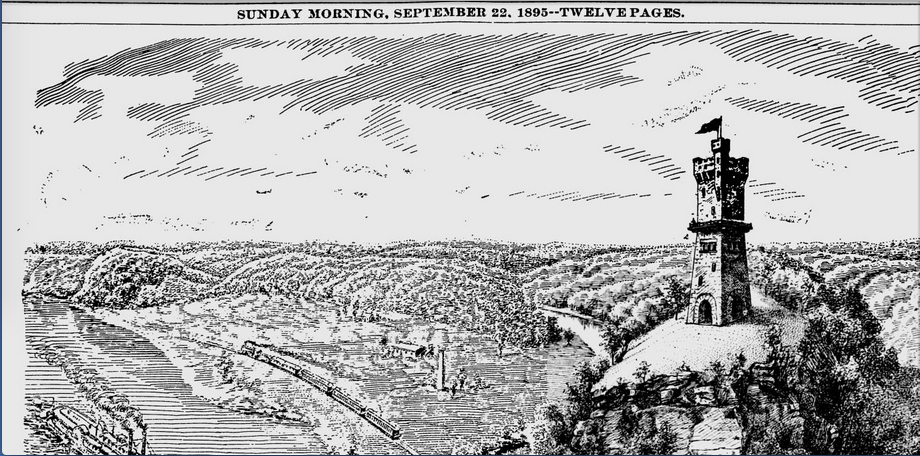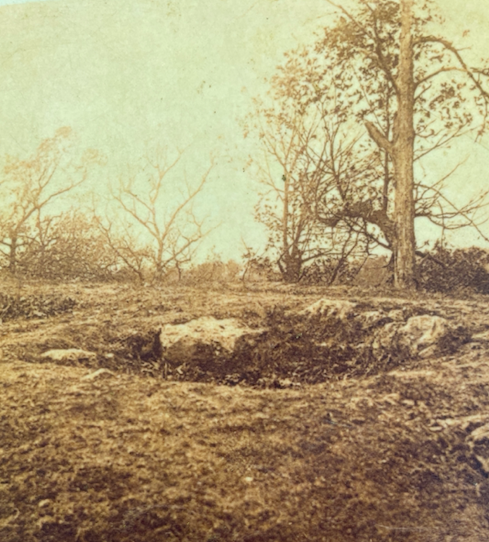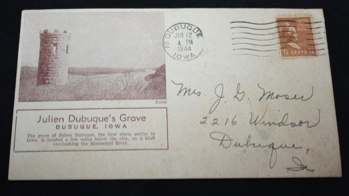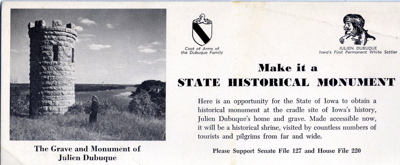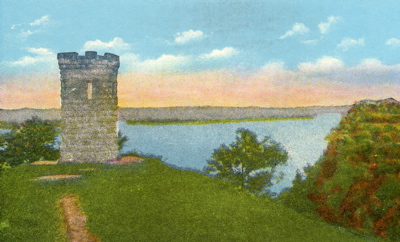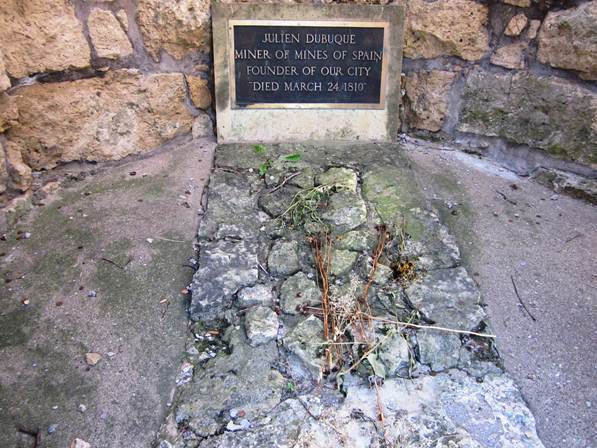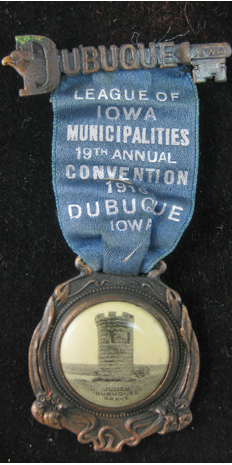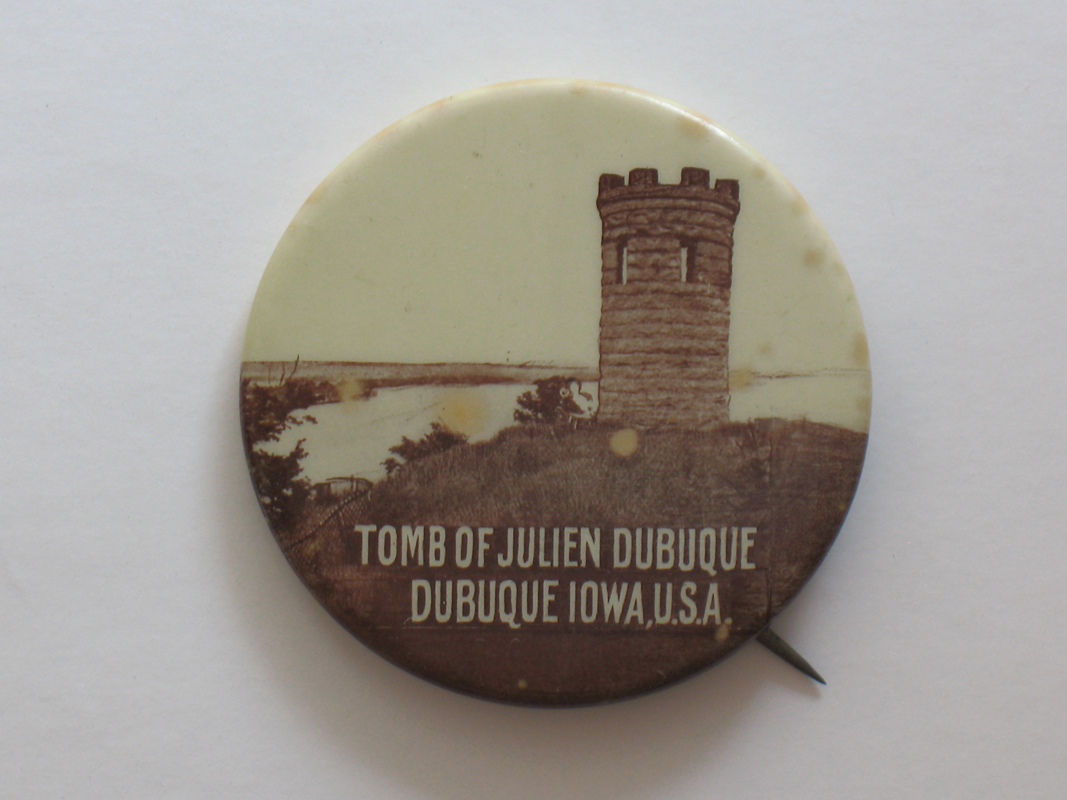Encyclopedia Dubuque
"Encyclopedia Dubuque is the online authority for all things Dubuque, written by the people who know the city best.”
Marshall Cohen—researcher and producer, CNN
Affiliated with the Local History Network of the State Historical Society of Iowa, and the Iowa Museum Association.
JULIEN DUBUQUE MONUMENT
JULIEN DUBUQUE MONUMENT. Julien DUBUQUE died of pneumonia on March 24, 1810 and was buried on the bluff above CATFISH CREEK. His grave was covered with a wooden and stone shelter complete with a gable roof and open window through which Native Americans believed the soul of the departed could leave. At the apex was a wooden cross made by white friends. The stone building was still intact in 1845. (1)
Controversy remains as to the inscription on the grave. George CATLIN who visited the grave in 1835 believed that Dubuque had written an inscription for himself giving his name, "Miner of the Mines of Spain," and his age. It is more likely that French Canadians left an inscription on a cedar cross. Several versions of these early years all agree that between 1827 and 1829 a cedar cross and cedar hut were constructed over the mound of rocks.
By the time of the CIVIL WAR, souvenir hunters had removed the hut and cross. There was even an often repeated story that the bodies of Dubuque and Peosta had been discovered by a curio collector in a lead coffin and taken away during this time. (2) Franklin T. OLDT offered another story in his book The History of Dubuque County, Iowa. According to a Mrs. Dexter who lived south of the city, vandals broke into the grave and removed the lead coffin in which Dubuque's remains had been buried. They scattered the bones among stones and pieces of wood and stole the coffin. Mrs. Dexter found a lower jaw bone which she claimed was Dubuque's and kept it for years. (3) In 1879 the Daily Herald carried the following story:
The party who tried to rob the grave of Julien
Dubuque a few days ago, failed to find any bones
of his or of anyone else. One of his three skulls
is said to be in Cincinnati, another in Boston,
and we know a man who knows another man who knows
where the genuine skill is. The grave was first
rifled nearly forty years ago. (4)
Interest in a monument to Julien Dubuque was discussed at the November, 1892 meeting of the EARLY SETTLERS' ASSOCIATION. There was a definite sense of urgency expressed:
By all means let us get the monument up before ruthless destroyer
of traditions or matter of fact disputant of what is supposed to
be authenticated history comes along and proves that Dubuque was
only a myth. (5)
E. A. Fox from Chicago attended the meeting and offered a design and plan for a granite shaft thirty-seven foot high costing $3,700. He was also ready of offer a smaller version at a lower price. The man was reportedly upset when a competitor, William Gill, a local marble cutter mentioned that he had already submitted a design. The group generally agreed that the monument should be on the bluff over Catfish Creek and the suggestion was made to purchase a few acres for a park. (6)
On November 20, 1892 it was announced that the design of E. A. Fox of Chicago had been accepted. The base of the thirty-seven foot granite shaft would feature relief bronze plaques three feet in diameter showing scenes of Dubuque's first experience in the area. These bronzes would be manufactured in Brussels and would cost $300 each. The peak of the spire was designed to depict curtains drawn apart symbolizing "Dubuque's prophesy that a great city would grow up in this locality." Peter KIENE and Joseph HEROD agreed to donate four acres of land for the proposed park. Alderman Crawford suggested, however, that the city should purchase forty acres. With work to be completed by July 4, 1893 the suggestion would be made to invite "all the great men of the nation" to a great celebration. (7)
The effort to secure funding failed. On August 8, 1895 the Dubuque Daily Herald reported that two young men had found the cross that marked Dubuque's grave missing, stones which had marked a square around it thrown about, and an attempt at an excavation of the grave was visible. (8)
On August 22, 1895 it was announced by the EARLY SETTLERS' ASSOCIATION OF DUBUQUE COUNTY (THE) that a design by Alexander Simplot had been chosen. The design, suggesting "a deserted castle on the Rhine," would be made of marble. It would stand eighteen feet wide at the base and forty-five feet in height to a peak twelve feet wide. A public park of thirty acres would be created with a house for a park custodian. On special occasions the ILLINOIS CENTRAL RAILROAD would operate special trains between the city and the site. (9) On October 21, 1895 the OLD SETTLERS' ASSOCIATION decided to incorporate as the Julien Dubuque Monument Association. A committee was appointed to draw up articles of incorporation and it was decided that the officers should be a president, secretary, treasurer and seven directors. (10)
In 1895 the Early Settlers' Association was still attempting to arouse interest in erecting a monument over Dubuque's grave. (11) On October 17, 1895 a group of its members along with the Dubuque members of the IOWA INSTITUTE OF SCIENCE AND ARTS met to further those plans. (12) Chaired by Philip Pier with Alexander SIMPLOT as secretary, the meeting began with a history of Julien Dubuque. Simplot then moved that a committee of five people be appointed to gather contributions for the purchase of land and the erection of a monument. Judge Lenehan suggested that two people come from each of the city's wards. This was approved. (13) There were already two acres of land adjoining the site of the grave for the use of the Old Settlers' Association. One belonged to KIENE, Peter and the other was owned by Fridolin HEER. (14)
On February 28, 1896 the Julien Dubuque Monument Association was formally organized. Philip PIER served as chairman and Alexander SIMPLOT was the secretary. The board of directors included Joseph P. Quigley, Julius K. GRAVES, Christian Anton VOELKER, Fred TSCHUDI, Peter KIENE, George Wallace JONES, Charles H. GREGOIRE, J. MACLAY, Patrick H. HALPIN and Alexander Simplot. The organization was capitalized at $10,000 with shares selling for five dollars. (15)
There were five burials found at the site of the present monument as work was done placing the foundation of the monument. As recorded by Richard HERRMANN: (16)
Julien Dubuque, lying down full length facing to the west
Chief PEOSTA, semi-sitting position, facing to the west
POTOSA, Julien Dubuque's wife, full length, facing to the west
Chief ROLLING CLOUD, a Fox Indian, sitting in the hut,
facing to the east Gray Eagle, a Sauk Indian, sitting in the
hut, facing to the east.
The discovery of the skeletons, as described by Herrmann, was recounted:
Shovel by shovel the earth came out of the space between the old
foundations of the hut and all of a sudden we came upon a skeleton.
...I puzzled it out that the skeletons carried away were those of
Grey Eagle and of Rolling Cloud (believed to have been Dubuque's son).
...I insisted we go father for I believed that we would find another
skeleton still further down...Surely enough, just off to one side of
the first skeleton we found a single skull and between the two a
number of small ARROWHEADS and a pipestone pipe...Going down a few more
feet we came upon a second skeleton, headless, which I believe without
a doubt is the skeleton of Julien Dubuque. You see Dubuque and Peosta
were such good friends and when Peosta died, some years after Dubuque,
he was buried in the same mound and the Indians, wishing to put the
two as close together in death as they had been in life, dug up
Dubuque's skull and buried it with Peosta with the pipe between them
as a symbol of their friendship...From my knowledge of Indian customs
(I believed) Dubuque's wife was not buried in the same mound. I had
the men dig a little to the south of the foundations of the little hut
and there we found the skeleton of a woman undoubtedly that of Dubuque's
wife, Potosa. (17)
The remains discovered in the excavation were carefully reassembled and arranged for viewing at the HERRMANN MUSEUM, the curator's home. The Dubuque Sunday Herald stated that they were arranged "upstairs in a vacant room on a bare floor, where they were lying in perfect position." By his side were the bones of Peosta. The article indicated that many people were planning on visiting the construction site of the monument which was then seven feet above the ground. (18)
On Sunday, October 31, 1897, the remains of Dubuque, laid inside a walnut box made by the DUBUQUE CABINET MAKERS' ASSOCIATION, were buried inside the monument familiar to visitors today. Taking advantage of a new road the supervisors had constructed, an estimated 500 drove carriages to the ceremony with "not less than 2,000" attending the services--some arriving by boat and others using the Chicago, Milwaukee and St. Paul railroad. The twelve-feet in diameter, 29-feet tall, limestone structure costing $560 was paid for by the Old Settlers Association and the IOWA INSTITUTE OF SCIENCE AND ARTS. (19)
The ceremony began at 3:00 p.m. Beginning the ceremony, a chorus of thirty singers of the Saeugerbund Society sang "The Day of Our Lord." Dr. J. P. Quigley introduced the principal speaker, James H. SHIELDS. The chorus then sang "The Heart's Repose." Dubuque's remains were buried with copies of the Dubuque Herald, a biographical sketch of Dubuque, a paper giving the history of the movement to build the monument, names of contributors to the monument fund, and an account of the anticipated ceremony by Richard Hermann, copies of the local newspapers and a list of officials. Among the others present were delegations of five pupils from each of the public schools including the high school. (20)
On April 29, 1898 members of the DAUGHTERS OF THE AMERICAN REVOLUTION, EARLY SETTLERS' ASSOCIATION, and many school children traveled by boat to the site of the burial of Julien Dubuque to honor Arbor Day. Eleven trees were planted and numbered corresponding to schools in the city and sponsoring organizations: Prescott (1), D.A.R. (2), Irving (3), Franklin (4), Early Settlers (5), Marshall (6), Fulton (7), Lincoln (8), High School (9), Audubon (10), Jackson (11). (21)
In 1907 members of the OLD SETTLERS' ASSOCIATION offered the deed to the ground occupied by the monument and the small park around it to the county board of supervisors. The understanding was that the land would continue to be used for the park and monument exclusively. (22)
In 1931 an effort was made to provide public access to the grave site. Road construction proved difficult as the weather was warm and materials were not easily accessible. The decision was finally made to construct an ungraded road of cinders. Heavy iron boiler shells were used to fill in gullies and deep holes. (23)
Dedication ceremonies were scheduled for October 18, 1931. To add to the occasion, four-full-blooded SAUK AND FOX from Tama County, Iowa were persuaded to perform. However when told they should stay in a wigwam at the site over the weekend, the Native Americans announced that they had no idea where one could be found or how to make one. The four who were to perform simply refused to live in such a dwelling and settled for a hotel room with free meals. (24)
Despite the problems, the dedication was a success. On the day of the death of Thomas Edison and the conviction of mobster Alphonse CAPONE for income tax evasion, more than one thousand people came to the dedication. Many arrived by car which cost them a twenty-five cent toll. The road was used for awhile, but washouts and the toll eventually led to people returning to the foot path up the hill. (25)
In 1935 Secretary of Interior Harold L. Ickes submitted a bill to Congress that would make the grave of Julien Dubuque and the Effigy Mounds open for immediate consideration by the National Park Service. Until the presentation of the bill, the Park Service had been prevented from participating in the support or preservation of historic sites other that those which were acquired by the United States for that purpose, either through gift or purchase. (26) Eventually the Effigy Mounds were established as a national monument.
In 1963 eighteen acres of wooded land surrounding the grave of Julien Dubuque were made ready to be designated Julien Dubuque Park. The area included an access road and 12.3 acres donated in 1948 by Herman LOTT and his wife Marcella and 5.8 acres owned by the City of Dubuque. About $28,000 had been allocated from state funds to develop the area along with $2,500 for survey and development work. The Chamber of Commerce Vacationland Committee, Dubuque County Conservation Board with city, county, and state officials had worked together to see that the project was completed. (27)
The 1963 dedication, however, was postponed because Roger J. RHOMBERG chairman of the Chamber's Vacationland Committee, declined to invite park visitors to drive down the only road available to reach the park. The road veered off Rockdale Road down a gravel road used by quarry trucks. The ILLINOIS CENTRAL RAILROAD, however, had not wanted another crossing over its tracks. Renewed negotiations led to an access road, not the 1948 access provided by Lott, that was acceptable. (28)
See: CITY LANDMARKS
---
Source:
1. Brimberg, Judith. "Indian Trail Leads to Blufftop Grave," Telegraph Herald, May 17, 1959, p. 9. Online: http://news.google.com/newspapers?id=AJNFAAAAIBAJ&sjid=07wMAAAAIBAJ&pg=4613,1863282&dq=richard+herrmann+dubuque&hl=en
2. Ibid.
3. Herrmann, Richard "How the Remains of Julien Dubuque Were Brought to Light After Seventy Years," Telegraph Herald, April 24, 1910, p. 12
4. "Caught on the Fly," Daily Herald, August 10, 1879, p. 4
5. "J. Dubuque Esq." Dubuque Daily Herald, November 16, 1892, p. 4. Online: https://news.google.com/newspapers?nid=_OG5zn83XeQC&dat=18921116&printsec=frontpage&hl=en
6. "The First Settler," Dubuque Daily Herald, November 17, 1892, p. 4. Online: https://news.google.com/newspapers?nid=_OG5zn83XeQC&dat=18921117&printsec=frontpage&hl=en
7. "Early Settlers Elated," Dubuque Daily Herald, November 20, 1892, p. 4. Online: https://news.google.com/newspapers?nid=_OG5zn83XeQC&dat=18921120&printsec=frontpage&hl=en
8. "Dubuque's Grave," Dubuque Daily Herald, August 7, 1895, p. 9
9. "A Monument," Dubuque Daily Herald, August 22, 1895, p. 8. Online: https://news.google.com/newspapers?nid=_OG5zn83XeQC&dat=18950822&printsec=frontpage&hl=en
10. "Will Incorporate," The Dubuque Herald, October 22, 1895, p. 8
11. Oldt, Franklin T. History of Dubuque County, Iowa. Chicago: Western Historical Company, 1880, Online: http://books.google.com/books?id=u9xDAAAAYAAJ&pg=PA464&lpg=PA464&dq=Burton%27s+Furnace+%28dubuque+history%29&source=bl&ots=0CkCGLFR0v&sig=a0Ou1vN3ew6nQUYoq2aOJsXF9Mg&hl=en&sa=X&ei=j3HVT5XALaP42QXVp9iFDw&ved=0CGgQ6AEwBQ#v=onepage&q=Burton%27s%20Furnace%20%28dubuque%20history%29&f=false (page 504)
12. "Julien Dubuque," Telegraph Herald, Oct. 18, 1895, p. 8. Online: http://news.google.com/newspapers?id=m7BFAAAAIBAJ&sjid=LL0MAAAAIBAJ&pg=5047,5033246&dq=julien+dubuque&hl=en
13. Ibid.
14. Ibid.
15. "Ready to Work," Dubuque Daily Herald, February 29, 1896, p. 8
16. "Julien Dubuque, Adventurous Spirit; Called Little Cloud by Fox Indians, Historian Declares," Telegraph Herald, Feb. 26, 1933, p. 9. Online: http://news.google.com/newspapers?id=4v1QAAAAIBAJ&sjid=Or4MAAAAIBAJ&pg=2539,2728957&dq=julien+dubuque&hl=en
17. Herrmann, Richard, p. 13
18. Moran, Joe. "They Laid Dubuque's Skeleton in the Tomb," Telegraph Herald, September 4, 1955, Dubuque News, p. 1
19. "R.I.P., Julien," Telegraph Herald, November 25, 1973, p. 20
20. "Entombed Again," The Dubuque Herald, November 2, 1897, p. 7
21. "Patriotic Event," The Dubuque Herald, April 30, 1894, p. 8
22. "Wish County to Preserve Ground," Telegraph Herald, June 18, 1907, p. 16. Online: http://news.google.com/newspapers?id=EtlBAAAAIBAJ&sjid=26kMAAAAIBAJ&pg=2625,4102350&dq=julien+dubuque&hl=en
23. Stowell, John. "Park at Julien Dubuque's Gravesite Not New Idea," Telegraph Herald, November 18, 1962, p. 21
24. Ibid.
25. Ibid.
26. "Grave of Julien Dubuque May be National Park," Telegraph-Herald and Times-Journal, March 14, 1935, p. 2
27. "Plans Ready for Julien Dubuque Park," Telegraph Herald, Feb. 7, 1963, p. 28. Online: http://news.google.com/newspapers?id=Y49FAAAAIBAJ&sjid=5bwMAAAAIBAJ&pg=3194,4156713&dq=julien+dubuque&hl=en
28. Stowell, John. "Julien Dubuque Park Access Road Still 'Mired'," Telegraph-Herald, May 3, 1964, p. 9
Pratt, LeRoy G. Discovering Historic Iowa, Iowa Department of Public Instruction, 1975



